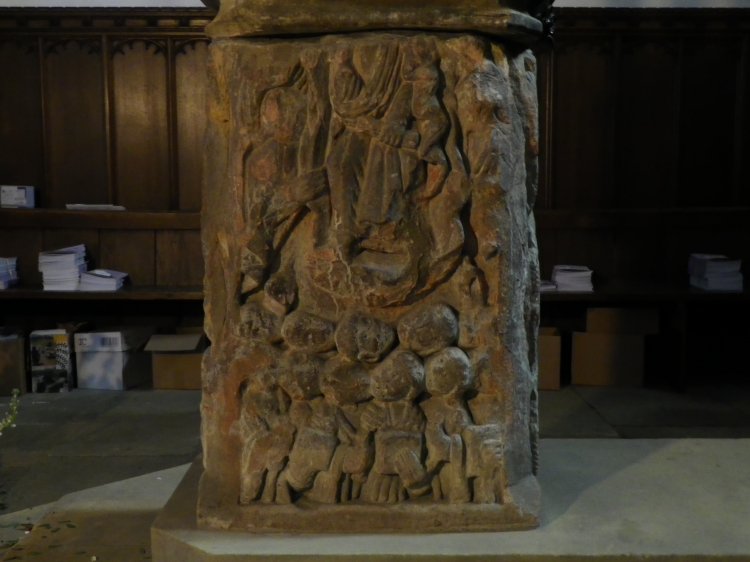Contributory members are able to log private notes and comments about each site
Sites Anne T has logged on trip number: 119 (View all trips)
View this log as a table or view the most recent logs from everyone
The Rothbury Cross
Trip No.119 Entry No.1 Date Added: 25th Feb 2019
Site Type: Ancient Cross
Country: England (Northumberland)
Visited: Yes on 24th Feb 2019. My rating: Condition 3 Ambience 4 Access 5

The Rothbury Cross submitted by Modern-Neolithic on 26th May 2013. The north panel displays "The Accession of Christ" with angels either side and the apostles looking upwards.
(View photo, vote or add a comment)
Log Text: The Rothbury Font/Anglo Saxon Cross & Other Fragments: We started off in Rothbury, parking on Haw Hill, just outside the church. We intended to go for a cup of tea, but the town was inundated with tourists and bikers, so we went straight to the church to find the font. I’d forgotten how glorious this was, but then it’s a long time since we looked in the church.
There were odd lights in the church, highlighting a few pieces, including the font, but it was so dark under the tower that, after hunting unsuccessfully for the light switches, we had to go and get the large flash gun from the car.
I also photographed the pieces on the west interior wall of the porch, and a sundial to the south of the nave. At the NW corner of the tower, there was a collection of fragments and a bell. The sign said: “These fragments of an Anglo Saxon Cross was discovered during recent building work in the All Saints Churchyard. It is believed to have been a carving that broke as it was being worked on”. The way the fragments were stacked in a jumble made it impossible to see any carvings on them.
We missed two scratch clocks on the exterior south wall; I looked for a church guide book, but the only thing on display were postcards, cards and the parish magazine.
On the western wall of the south transept, on the window sill, is a modern carving. The sign reads: “This carving celebrates the 500th anniversary of Bernard Gilpin. It depicts a historic incident in Rothbury Church. Bernard Gilpin was a Catholic priest whose brave efforts to bring Christianity and peace to the warring families of the Borders eventually earned their respect. They rewarded him with the honorary title of The Apostle of the North. Queen Mary order Gilpin to be brought to London to be burnt at the stake as a heretic. However, the Queen died before he reached London so he was able to return to the North to continue his good works”.
The notice board by the Font reads:
“The pedestal consists of the base of the ancient Saxon cross of Rothbury dating from the 8th century AD.
East Side: Before the Fall of Man
North Side: The Ascension of Christ with angels wither side and the Apostles looking upwards. The Evangelicals hold their gospels (this is said to be one of the oldest carvings of this subject in Britain).
West Side: After the Fall
South Side: The Saxon knot-work pattern
Other fragments of the Rothbury Cross are in the Museum of the Society of Antiquaries of Newcastle upon Tyne (Great North Museum). [The bowl is dated 1664].”
Steng Cross and Winter's Gibbet
Trip No.119 Entry No.2 Date Added: 25th Feb 2019
Site Type: Ancient Cross
Country: England (Northumberland)
Visited: Yes on 24th Feb 2019. My rating: Condition 3 Ambience 4 Access 4

Steng Cross and Winter's Gibbet (Elsdon) submitted by Anne T on 25th Feb 2019. It's not until you walk almost up to the cross base that we realised how much larger it is than others we've seen. Pastscape records: "It measures 0.8m square chamfered down to 0.6m square, and stands to 0.4m above ground level, the socket stone is 0.4m by 0.25m and is 0.2m deep".
(View photo, vote or add a comment)
Log Text: Steng Cross & Winter's Gibbet, near Elsdon: If there was a category for Ambience = Spooky/Very Spooky I would assign it to this site.
This is a remote spot, at the very top of the moor at the western end of the forest which runs along the north side of the road. The thought of anyone being hung in chains and left to rot, murderer or not, doesn't bear thinking about. I expected to turn around and find the ghost of William Winter breathing over my shoulder at any moment. Even the birds seemed silent with the cold wind whistling along the long, straight road nearby. I was glad to escape back to the car and head off to Elsdon.
Just inside Northumberland National Park, St Cuthbert’s Way runs on the south side of the fence next to the cross, although to get to it you have to walk back to the road, a little further west, then onto the marked footpath.
The Elsdon Stone
Trip No.119 Entry No.3 Date Added: 27th Feb 2019
Site Type: Early Christian Sculptured Stone
Country: England (Northumberland)
Visited: Yes on 24th Feb 2019. My rating: Condition 3 Ambience 4 Access 4

The Elsdon Stone submitted by Anne T on 27th Feb 2019. This is the unique Elsdon Stone, which is sited against the north wall of the nave, opposite the south door into the church. The inscription is barely visible unless the light catches it. There is a notice above with an explanation of the stone with a brief history of the Roman officer, and what remains of the legible inscription, in Latin.
(View photo, vote or add a comment)
Log Text: St Cuthberts, Elsdon (The Elsdon Stone): We stopped off at the very friendly and informal tea shop for tea (one tea bag in a pot for 2) and an ‘omelette sandwich’ (was supposed to be fried egg, and it took me a while to recover from the taste). We’ve been to the church before, but not with the HE and Pastscape information with us.
Spotted the unique Roman soldier’s tombstone (it lists his entire military career), the medieval cross slabs and the horse skulls. We thought we’d seen everything in this church on a previous visit on 25th August 2013, but indeed missed a great deal. Whilst I photographed most of what we took in today, at the time I wasn’t so interested in the medieval grave slabs and the Elsdon Stone (after all, it was only Roman, wasn’t it?!). I really wished I’d thought to take Peter Ryder’s articles on the medieval grave slabs, but until we got to the village, had no real thought of going back to the church.
I was really saddened to see how much the inside of the church has deteriorated since our visit four and a half years ago. There is so much black mould and dust around, especially towards the western end of the church.
I also hadn’t realised how complicated the stone work around the junction of the nave and the transept was – all small spaces and intricate junctions.
I could have spent all afternoon the churchyard photographing all the amazing grave markers.
Rugley Walls (Cambo)
Trip No.119 Entry No.4 Date Added: 27th Feb 2019
Site Type: Holy Well or Sacred Spring
Country: England (Northumberland)
Visited: Saw from a distance on 24th Feb 2019. My rating: Condition 2 Ambience 3 Access 4

Rugley Walls (Cambo) submitted by Anne T on 27th Feb 2019. The site of the holy well, as seen from the road, which shows up as a puddle and a brighter green grass against the rest of the pasture. A return trip in better light, more time and a pair of wellies will occur in the relatively near future …..
(View photo, vote or add a comment)
Log Text: Rugley Walls Holy Well: (note wellies a must if trying to get to the well): We stopped off here very quickly as we wanted to leave enough time to see the settlement at Catcherside.
Whilst we could see the source of the well, and there was a gate into the field, we would have need our wellies to get over the stream and boggy area to reach the well. As the light was starting to fail, we elected to carry on to Catcherside.
The well is shown on HE map but no mention on Pastscape. I need to look up the Holy Wells of Northumberland papers. All indications from Keys to the Past are that the well is connected to the deserted medieval village of Rugley Walls, which lies to the eastern side of the B342 road which runs through here.
I'd really like to see the structure that Andy Curtis photographed, so a return visit is on my wish list.
Camp Hill (Catcherside)
Trip No.119 Entry No.5 Date Added: 28th Feb 2019
Site Type: Hillfort
Country: England (Northumberland)
Visited: Yes on 24th Feb 2019. My rating: Condition 3 Ambience 4 Access 4

Camp Hill (Catcherside) submitted by Anne T on 28th Feb 2019. Standing in the deepest part of the ditch towards the north western part of the hillfort, looking north east towards Catcherside Farm.
(View photo, vote or add a comment)
Log Text: Camp Hill Hillfort, Catcherside, Knowesgate: We drove up to Catcherside, which was very obviously a very well looked after cluster of farmhouses with a common courtyard between. As Andrew was looking for somewhere to park, a man walked out of Catcherside Cottage so I leapt out of the car and asked if it would be OK if we could park for 20 mins to go and look at the settlement. He said it was his daughter’s farm, but went away to ask, came back and said that was OK. As Andrew came back from parking a little way out of the lane, he hadn’t brought my walking poles, so the gentleman lent me one of his. Nice!
As we walked by the gate into the garden of the cottage, I spotted a carved stone at NY 99191 87596, which looked like a round cross or pillar base (reminded me of the one we saw at Bamburgh Castle in the Stones Museum).
The farmland here looks really fertile, and the sheep were magnificent. The hillfort has been ploughed out on the southern and south western side, but the ditch, rampart and hollow way through the entrance on the north western sides are still clear. We did look for signs of structures within the oval platform at the top of the hill, but these looked as if they had been ploughed out by rig and furrow. A really nice walk on a warm February evening.
